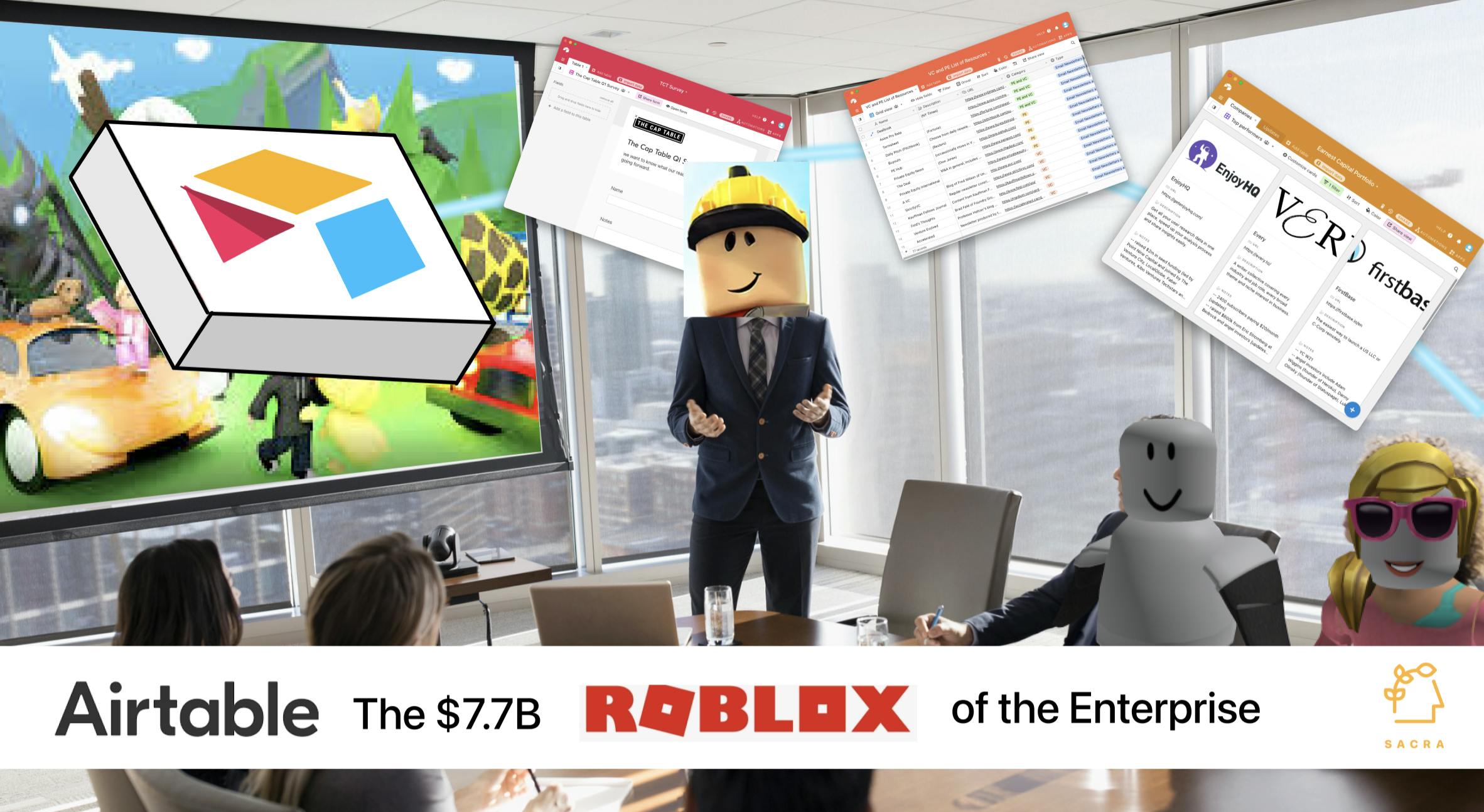Zoelle Egner, early Airtable employee, on customer success for product-led companies
 Jan-Erik Asplund
Jan-Erik Asplund

Background
We talk to early Airtable employee Zoelle Egner about why Airtable's focus on customer success was crucial, how Airtable finds new use cases inside organizations, and the future of no-code.
Questions
- Could you start by talking a little bit about the evolution of your role at Airtable?
- Can you talk a little about Airtable’s shift from consumer and more towards enterprise?
- Is part of the reason that top-down sales can be harder for tools like Airtable because it’s hard to compare it one-to-one to other tools?
- What are the main verticals where Airtable has come in via this kind of bottom-up adoption?
- In an enterprise setting, where a lot of different people are going to touch Airtable, how do teams manage that complexity so that bases don't get broken?
- Can you talk about the likelihood of teams spinning up a base to handle some job and then eventually graduating to an off-the-shelf product once they hit Airtable's limits?
- What parallels or lessons do you take away from having worked at both Box and Airtable?
- Is there a big thing that you feel that the market doesn't understand about Airtable?
Interview
Could you start by talking a little bit about the evolution of your role at Airtable?
Absolutely. All right. So I started at Airtable in October of 2015, and I was originally brought in to do mostly marketing.
When I first started, that meant two things, product marketing, but most explicitly sort of launch, because there wasn’t a launch motion at that point, and then anything related to content or words at all.
At some point thereafter, relatively quickly, but within less than a year, I had been watching very closely the way that our sign-ups were evolving, and made a push for customer success.
We had spent so many hours talking to a ton of individual customers, and then realized that there were a bunch of Fortune 500 organizations signing up, and we had absolutely no idea how they were using the product differently or what they were using the product for.
I had worked in customer success previously when I was working at Box and so knew that Fortune 500s were going to have very different expectations.
They likely were using the product in very different ways, et cetera. So I ended up pitching and then getting to build out the customer success team as well.
Customer success actually predated sales at Airtable and then was separate from it very intentionally for a very long time. We really saw it as a direct conveyor belt: listening to customers, hearing how they talked about their really specific problems—because the product was so horizontal—and then pushing that directly into our marketing across the different verticals we were prioritizing.
We wanted to have those really deep relationships on the customer success side, because retention and expansion was the key to our success.
Can you talk a little about Airtable’s shift from consumer and more towards enterprise?
When I started at the company, we hadn't even decided to be B2B. The founders were really convinced that they were going to see viral end user consumer adoption in the same way that Dropbox or Evernote had. That was sort of the thesis and that they would eventually move into business, but they would start with consumers.
Just being frank with you, we absolutely did not see that. What we did see was that when businesses were signing up, then we would see viral adoption within the businesses. So we ended up sort of shifting to focus primarily on businesses, not explicitly enterprise, but lots and lots and lots of small businesses. That’s still really a foundation of the business.
But that shift towards more enterprise happened earlier than you might even have anticipated, and part of the reason was because we started getting Fortune 500s reaching out, being like, "We will pay you now."
And one of the reasons we knew sort of we were moving in the direction of product market fit was that people were going and hunting down ways to try and pay us because they wanted it to continue to exist.
That was a pretty big wake-up call for us that maybe we were really onto something. We should be focusing on those use cases and in those larger companies where maybe we were actually more valuable than we had anticipated being.
So that's when we brought in customer success, when we started having those conversations, and we honestly got away with serving huge enterprises without having real sales for far longer than any company has any right to, because the product was so incredibly popular within those companies.
You would see a company go from a single team of 40 people to dozens of teams and more than 1,000 users in less than a year. Some of those were paid.
Some of them would be free, but it's a very, very different conversation with IT when you're going in being like, "Hey, so there's 1,000 people who are going to be super angry if you don't figure this out. Sorry."
That was our bottom- up strategy: build a huge user base, and over-invest from a customer success perspective. We had really deep relationships with those people.
We were going in and doing trainings. We'd build custom content for them. We were onsite. I was in New York fucking all the time, working directly with those customers, as were people like Shani, really to get those incredibly deep relationships and insights.
Then sales at that point was more of a "Make sure IT signs off on this" kind of a thing. It was very push them through a process, make sure that we fill out the security questionnaires, all that stuff. It wasn't really persuasive per se. It was much more like they're trying to give us the money, figure out how much it should be, and get rid of any roadblocks and focus a lot on capitalizing on that growth.
When that change finally happened, much later—because we were able to ride that for quite some time—we had so few people internally that we were always super oversubscribed if you were trying to get an enterprise deal from Airtable.
Is part of the reason that top-down sales can be harder for tools like Airtable because it’s hard to compare it one-to-one to other tools?
That changed not so much because we needed to go further up market— we were already working with huge enterprises and had been for years— but because the thesis of the company became that we could do that all faster by layering on a tops down sales motion and selling directly without necessarily always having a base of users in place.
It's a really interesting question. I think that nowadays there is a narrative that is possible to sell Airtable in a top-down sales motion, but that wouldn't have worked years ago, because the market was not ready for it. No one had any idea what we were. It’s taken time to build the foundation for the market to be ready.
I think we're going in the direction of this category narrative with the increase in the number of no-code tools that are out there. Eventually, the holy grail here is for IT leaders and innovation leaders within companies to realize that having a workforce that is empowered to solve their own problems in real-time is going to allow them to keep up or get ahead in the market.
Waiting for a vendor to add something to their roadmap and then take two years to build it is absolutely no longer acceptable, right?
You just can’t get away with outsourcing your problem solving like that anymore. It’s just too slow. So that narrative, what are the tools you need in order to allow your people who do the work to solve the problems, is eventually going to be really, really powerful, and Airtable will have a big place in that.
No one believes that's real yet except really, really forward looking companies. Which if you look at the companies that Airtable has talked about publicly, those are the ones that are already adopting really well because they're already starting to see that.
Airtable has even more of examples internally where that philosophy saved customers tons of money and allowed them to be moved faster than everybody else and all these other things. But it's not a widespread belief about the category value yet.
That's not compelling to anybody.
That's something that the no-code companies need to figure out and talk about really loudly. They just haven't done it.
I think it is still easier today to go bottoms up and very, very specific, because the way you can frame it is around extremely tangible business value that the business already understands because it's replacing inflexible tools or systems that are already screwing them over today, rather than being like, it can solve any problem.
What are the main verticals where Airtable has come in via this kind of bottom-up adoption?
I would actually disagree with that. Or rather, I would say that I think project management is not a useful frame because it means so many things to so many different people.
What you're seeing when you see us compared to something like Asana or whatever else is that it's the closest horizontal analog that people understand.
And because they're thinking there's only either super vertical tools or horizontal tools, they're like, "Okay. Well, I guess the horizontal thing. Sure, everything could be a project. Fine."
But those products are not actually designed for the way that work actually gets done anymore. In a lot of cases, they're more narrow than they are willing to admit to the market. And so it's just a bad proxy from my perspective.
Marketing is definitely one of the use cases we focused on.
There are two types of content use cases that were particularly compelling. One of them is marketing and one of them is not. So content marketing is one. Content as marketing.
The other is content production where content is the product. So that might be managing your slate of shows for your streaming provider. That's very different. Even though they're both content calendars, totally different use cases it turns out, fun fact.
There are three things that made marketing really, really interesting besides that it was not a well-solved problem.
One, content marketers love to talk.
They're all over Twitter talking to each other. They're constantly talking about their tools. There's a really strong community of people who are trying to improve their career prospects by talking about their tools. And that is super useful if you are a tool that is improving their career prospects, right?
So that was number one. Just chatty content people. I love them. I guess I'm one of them, but whatever.
Number two is content people tend to move around a little bit more.
There's a huge freelance community that's constantly bopping between different places. It's an evolving field, so everybody's trying to steal talent from each other and talent brings tools. So you get this really interesting viral adoption throughout the entire industry fairly quickly because the tool is being brought by the people who are doing the work.
You see that a lot as well in media and entertainment, which is why we're so successful in that particular vertical, right? If you're working on a movie, everybody's together for a bit, and then they separate. Same thing happens on TV, same thing happens... all of the talent is constantly moving.
That's very helpful if you're a tool that's trying to have viral adoption across many companies. You just get the seat in, they prove that it's super valuable for one thing and then everybody uses it for the next thing. Works great.
Then the final thing is that there were such huge market pressures on content, especially content as product. It's changing so quickly. The state of the art is not the same. There are new platforms every day, which means your playbook has to change every day. And in that context, anything that's super vertical specific cannot possibly keep up.
The process is always going to have to look really different for any given project. And that's where Airtable really shines: in places where everything is evolving too fast for you to have just one way of doing work.
So that was why those use cases were great. I say all that because you can imagine that I said the exact same things about several other industries.
UX research is actually one that we were super successful in. Product management was actually pretty useful for us. Generally with smaller companies.
When you get up to a bigger company size, product management is usually a more static process where there are more evolved tools. And at that point, people will have lots of strong opinions. So smaller companies, product management; bigger ones, less so.
And then there were a broad set of use cases that are hard to characterize so I'm going to call them operations. Like a rideshare app opening up new markets, right? It's a template they have to move to every new market. There's a whole run book that's very complicated and it's kind of being tweaked every time they run it.
That's something that Airtable is really, really good at because there's a set of data that has to go with it. There's a set of actions that have to occur.
Those things are very closely connected to each other. So you don't want to have to do meta work about the thing that's already in your system because that's going to have to change a lot. And you need a lot of visibility from a lot of different people.
Those operations use cases look different across every single industry. We had them in oil and gas. We had them in everything, you name it, but ops was always the best because ops people have their tentacles in every part of the company. They get to swoop in and look like a hero when they fix the weird, hard problems.
Our best evangelists were people who thought they were going to get ahead in their careers by being the ones who solves other people's problems, either by providing them with the tool or building the system. Over and over again, if you could find that person, they were the perfect first mover.
In an enterprise setting, where a lot of different people are going to touch Airtable, how do teams manage that complexity so that bases don't get broken?
And then, once you got them, the person who was actually going to get you the lucrative enterprise contract are all of the people who are what I would call translators.
They sit between people doing work and people who want results and they manage the process and make sure they translate between the two. And those are the people who are building systems. Those are the people using Airtable. Those are the people who can make an argument for budget in a way that a tinkerer who's sitting around drinking wine on a Tuesday playing with Airtable is not always going to get you budget.
They will get you in front of the right people who can, but they're not going to do it themselves.
Yeah. So there are three different components to this.
The first is you will have noticed that there's been a really big increase in product decisions related to allowing you to annotate everything, right? There's descriptions at every possible level of the hierarchy of the product. You can embed videos everywhere, all that stuff. That's because having embedded documentation is absolutely critical to anything happening, right? That's number one.
Permissions are also a piece of this so that people don't fuck things up, because if you didn't build the system, it's really historically been easy to break it. We made a lot of permissions so that was no longer the case. So there's the product pieces that are just guardrails and context.
The second two pieces both fall under customer success.
One is, unfortunately, if you rely on the customer to do the documentation, unless they are the greatest customer that has ever lived, it will not happen.
So the customer success managers do often do a very high amount of lift on that stuff, making sure that it's highly documented, that people feel comfortable doing trainings, recording the trainings, making sure that people go through the trainings.
Like they've set entire mini certification programs within companies in order to make sure people feel like they are ready to have more permissions. It's a whole system that they've built that's very robust and works very well, which is necessary when you're doing super mission critical stuff, right?
The other piece is that the customer success managers are constantly identifying people that they think could be internal trainers and champions and making sure that there's significant redundancy there.
So it is a problem internally if you only have one champion and only one person who understands the thing.
They will go out of their way to make sure that they have more, that more people are trained, and if somebody is leaving, that they figure out a way to backfill that person immediately because that's how you keep the memory of the thing alive internally and you don't get the problem you're talking about.
The other problem that this sort of thing helps to address is there is something that I will really dramatically call a complexity death spiral, where if you make your Airtable too complicated, you have to put in too much information, it's scary, whatever, people put off putting information into it because it feels hard.
And then it's out of date, and so they avoid it because they're like, "Oh shit, when I go in there, I have to fill in all this stuff I didn't fill in before."
And it just keeps getting more out of date and then it is useless.
And so customer success has all sorts of ways of making sure, one, it doesn't get too complicated in the first place, and that they start with something small and get bigger as necessary, rather than being like overly enthusiastic and making it impossible to use, and two, checking for signs of said death spiral because that's how you have a broken product that no one is going to use.
Can you talk about the likelihood of teams spinning up a base to handle some job and then eventually graduating to an off-the-shelf product once they hit Airtable's limits?
That stuff is useful. There's a reason why people made those.
Unfortunately, when you get to that scale, that's what's necessary to keep things alive. It doesn't matter how good your product is, if you allow users to drive the product, which is what we do, it is a user-driven product, they're going to make it complicated and you're going to need to help them make it simpler again.
Yeah, 100%. There was a lot of anxiety about this internally. What happened in practice is typically if you get one use case going really well and it's very intricate and effective and it's solving problems, yes, sometimes people are going to graduate to a different solution.
What parallels or lessons do you take away from having worked at both Box and Airtable?
Maybe they get to a scale where it doesn't make sense, whatever, that can happen, but I can name only a handful of times where other use cases have already not popped up by that point.
Because fundamentally, Airtable is really good for what we used to call edge apps. There's these core applications that run the heart of your business, and for ones that are very static like your CRM or your, I don't know, your ERP or whatever, is Airtable going to be the best thing for you in the long run at scale? No, don't use it for that.
But you know what it is really great for? Getting you to the point where you know you need to buy that thing and knowing all of the fields that you're going to have to put into Salesforce because you already figured it out yourself.
Generally speaking, that's what we saw, is that like, okay, sure, this big one maybe goes away, but the number of people who are now using it for 18 other things is so large, it doesn't matter. It's still a utility internally. That's like saying that if you used Microsoft Office to make your employee handbook, and then you decided to move it to something different, that somehow Office is no longer useful to you.
Yeah. So I mean, look, obviously I was employee 11 at Airtable. I came from Box. I brought a ton of Box to Airtable and there are even more Box people now at Airtable. So there's a lot of that DNA going on.
Is there a big thing that you feel that the market doesn't understand about Airtable?
One thing I brought and where I think we benefited from taking a lot of what they have done was the focus on customer success. They have an absolutely incredible customer success motion, which is how they managed to make so much money off of file storage, right? It makes no sense.
But the reason that that works is they have an incredible team of customer success people and implementation consultants and people who go in and fundamentally transform the processes that a business runs.
And that's incredibly sticky. It works really well. Most PLG companies don't care about customer success, and we super over invested in it, and that was because of Box.
Well, a million of them. One is they all seem to think that it's a project management tool or a spreadsheet. So there's that. Which is fine.
My philosophy on this was always, we were going to bring people on a journey once they started using the product and started getting value, and there were four specific aha moments they had to get to, to be like properly a champion who was really going to understand the full power and scope of the product, and that we could afford to be patient.
And it was okay if we were misunderstood because the rest of the market was not ready. Not everyone agrees with me on that, but whatever. That was a fight I decided intentionally, it was okay to lose in the short term.
All of our comps are weird. People all think we're very different than what we actually are if you use us. I'm sure when you've talked to the customers, you probably heard customers don't even really get it a lot at the time, and that's okay.
As long as you're getting value, it's fine if they don't fully get it. That's my opinion. That's the biggest piece. They know now that we're a hot company, that's nice, I guess.
But I don't think Airtable ever gets put into the ‘cult favorite’ category, which was very interesting to me. Because our audience that loves us the very most and gets the most value is just not that active on Twitter. A
nd so, I think a lot of people are like, "I don't know, I guess I used it for my deal pipeline, I guess it's fine. Sure, it's utility, whatever, it's everywhere."
They don’t think it’s like, beloved. But actually, a lot of normal humans use Airtable.
Disclaimers
This transcript is for information purposes only and does not constitute advice of any type or trade recommendation and should not form the basis of any investment decision. Sacra accepts no liability for the transcript or for any errors, omissions or inaccuracies in respect of it. The views of the experts expressed in the transcript are those of the experts and they are not endorsed by, nor do they represent the opinion of Sacra. Sacra reserves all copyright, intellectual property rights in the transcript. Any modification, copying, displaying, distributing, transmitting, publishing, licensing, creating derivative works from, or selling any transcript is strictly prohibited.








